Down Syndrome Research Funding by the National Institutes of Health
Down syndrome is the least-funded genetic condition by the National Institutes of Health (NIH). Below is information about the specific Down syndrome-related research the NIH has funded by institute, category and year since the NIH started to collect such details in 2008. These statistics are pulled directly from the NIH website and aggregated specifically for Down syndrome research.
Click here to view 2008-2011 Down syndrome-related research by institute.
Click here to view 2008-2011 Down syndrome-related research by NIH’s five categories.
Click here to view 2008-2011 Down syndrome-related research by year.
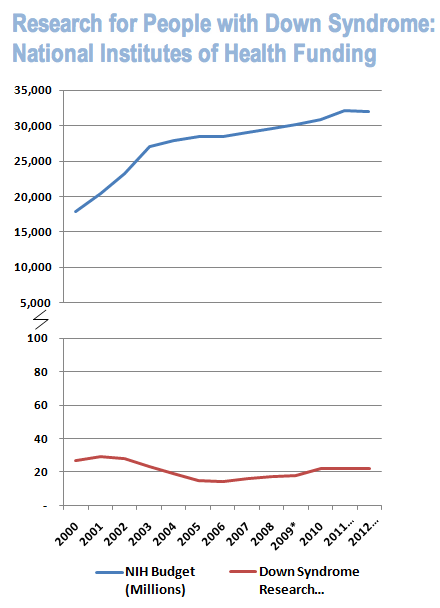 |
|
* 2009 figures exclude:
– $10.0 billion appropriated to NIH for short-term stimulus purposes under the American Recovery & Reinvestment Act (ARRA) available for obligation across a two-year timeframe until September 30, 2010.
– $4.0 million estimated additional funding for Down syndrome research as a result of the stimulus funding under ARRA across a two-year timeframe until September 30, 2010.
**2010:
– $6.0 million estimated additional funding for Down syndrome research as a result of the stimulus funding under ARRA across a two-year timeframe until September 30, 2010.
The addition of stimulus funds to NIH budget and Down syndrome research do not represent a significant net change in the amount of Down syndrome research funding to NIH budget.
National Institutes of Health (NIH) 2008-2011 Down syndrome-related research by institute
The Eunice Kennedy Shriver National Institute of Childhood Health and Human Development has been the “lead” funding institute for Down syndrome-related research from its inception in 1962. In part that is because the lifespan of a person with Down syndrome historically precluded adulthood and because the NICHD is the lead institute in intellectual and developmental disabilities. Down syndrome is the least-funded genetic condition by the NIH, and it is important to work closely with NICHD to ensure Down syndrome receives its fair share of research funding.
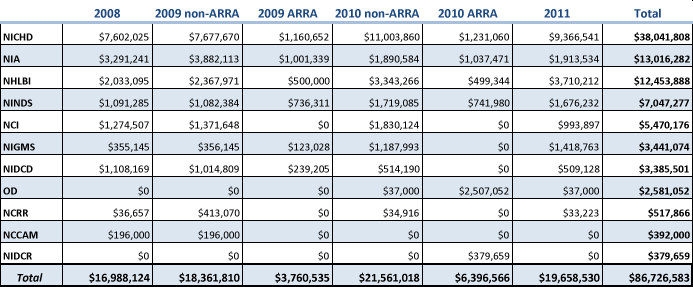
NICHD: National Institute of Childhood Health & Human Development; NIA: National Institute on Aging; NHLBI: National Heart, Lung, and Blood Institute; NINDS: National Institute of Neurological Disorders and Stroke; NCI: National Cancer Institute; NIGMS: National Institute of General Medical Sciences; NIDCD: National Institute on Deafness and Other Communication Disorders; OD: Office of the Director; NCRR: National Center for Research Resources; NCCAM: National Center for Complementary and Alternative Medicine; NIDCR: National Institute of Dental & Craniofacial Research
National Institutes of Health (NIH) 2008-2011 Down syndrome-related research by NIH’s five categories
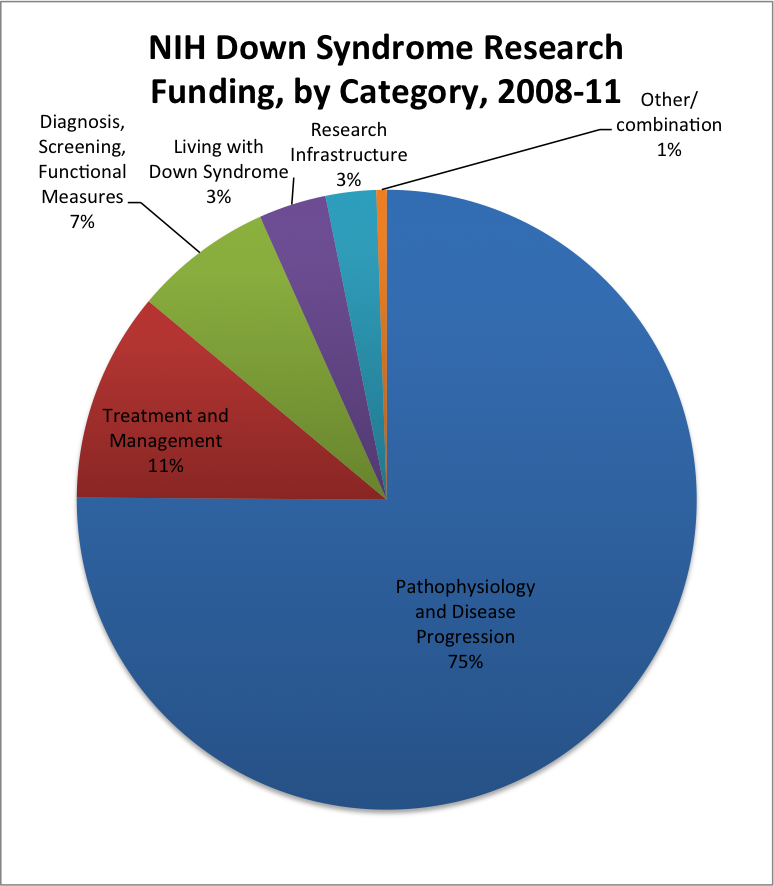 Down syndrome is the least-funded genetic condition by the NIH. In October 2007, the NIH published the “NIH Research Plan on Down Syndrome,” a plan developed by a then-newly established working group at the NIH, with the Eunice Kennedy Shriver National Institute of Childhood Health and Human Development serving as the “lead” institute for the group. The plan highlights five categories of research that the NIH should focus on as regards Down syndrome-related research:
Down syndrome is the least-funded genetic condition by the NIH. In October 2007, the NIH published the “NIH Research Plan on Down Syndrome,” a plan developed by a then-newly established working group at the NIH, with the Eunice Kennedy Shriver National Institute of Childhood Health and Human Development serving as the “lead” institute for the group. The plan highlights five categories of research that the NIH should focus on as regards Down syndrome-related research:
- Pathophysiology of Down Syndrome and Disease Progression
- Diagnosis, Screening, and Functional Measures
- Treatment and Management
- Living with Down Syndrome
- Research Infrastructure
Although the plan has many excellent suggestions and areas of focus that could benefit people with Down syndrome, until Down syndrome gets more overall research dollars, any such plans will be difficult to implement. Below is a list of Down syndrome-related research from 2008-2011, according to the five NIH categories.
National Institutes of Health (NIH) 2008-2011 Down syndrome-related research by year
Down syndrome-related research data from the National Institutes of Health can be found online dating as far back as 1989. The key years for funding are 2001 to 2003, when the funding went from $29 million, or 0.14% of the total NIH budget in 2001, to $23 million, or 0.08% of the total NIH budget in 2003. From that point on, funding for Down syndrome-related research spiraled downward and never recovered despite double-digit percentage growth of the NIH budget. Starting in 2008, in addition to overall condition or disease annualized research dollars, the NIH began to provide more data on what specific grants were funded and to categorize the type of research grant within the five NIH categories for Down syndrome-related research established by the NIH in the NIH Research Plan on Down Syndrome published in October 2007. Below is a list by year of NIH’s Down syndrome-related research funding.
Click on each year to download an Excel spreadsheet detailing grants related to Down syndrome research
2008 FUNDING FOR DOWN SYNDROME RESEARCH – $17 million, 0.06% of NIH total budget of $29.5 billion
2009 FUNDING FOR DOWN SYNDROME RESEARCH – $18.4 million, 0.06% of NIH total budget of $30.2 billion
2009 ARRA (American Recovery and Reinvestment Act) FUNDING FOR DOWN SYNDROME RESEARCH – $3.8 million
2010 FUNDING FOR DOWN SYNDROME RESEARCH – $21.6 million, 0.07% of NIH total budget of $30.9 billion
2010 ARRA (American Recovery and Reinvestment Act) FUNDING FOR DOWN SYNDROME RESEARCH – $6.4 million
2011 FUNDING FOR DOWN SYNDROME RESEARCH – $19.7 million, 0.06% of NIH total budget of $32.2 billion

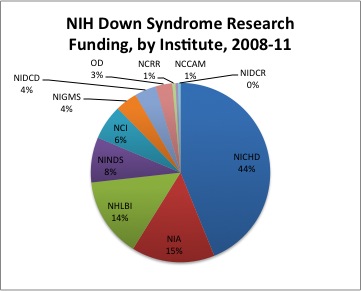
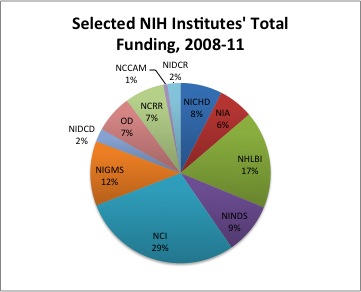


 Experience our inspirational and groundbreaking videos and photos. Our children and self-advocates are beautiful AND brilliant!
Experience our inspirational and groundbreaking videos and photos. Our children and self-advocates are beautiful AND brilliant! Make sure your local Representatives are on the Congressional Down Syndrome Task Force.
Make sure your local Representatives are on the Congressional Down Syndrome Task Force.